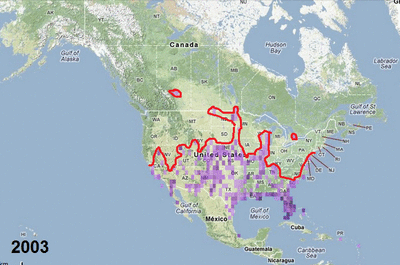 |
| Eurasian Collared-dove - Farmington Bay, Utah |
My fascination with the expansion of the Eurasian Collared-dove in North America continues. I was curious as to where they had expanded in the last year, so once again I resorted to eBird sightings maps which I animated. Amazing to see how much they have expanded in the last decade. I could try to verbally point out the pattern of northern movement, but you can just as easily see for yourself.
 |
| Flock of Eurasian Collared-doves at Farmington Bay, Utah |



It is amazing how fast Eurasian Collared Doves are expanding Robert!
ReplyDelete...I haven't seen any yet in Cincy, but I sure saw a lot in Florida last year and the year before! I had no idea they had expanded so far...
ReplyDeletePretty astonishing - have to wonder how it's affecting populations of Mourning Doves. I know people who say there are fewer in southern UT than there used to be, but I haven't seen any hard data to back that up.
ReplyDeleteToo bad we didn't have eBird back 150 years ago. It would have been interesting to see how the expansion of House Sparrows and Starlings occurred. I'm guessing it was much the same way as the EC-dove.
ReplyDeleteVery interesting, Robert! I am surprised at how fast the expansion has taken place.
ReplyDeleteThe spread of these birds is actually more common in western Canada than shown on your map. We've heard many reports from northern Alberta and BC, and even six of them reported in Yellowknife, NWT. Mourning doves however, have never gone that far north so people are generally delighted with the doves in their yard. Comments are still coming in on this post I wrote a couple of years ago - http://www.birdcanada.com/2010/03/wednesday-wings-eurasian-collared-doves/
ReplyDelete@Pat - so what you're saying is that we need more Canadian eBirders?!
ReplyDeleteHey Robert,
ReplyDeleteThey have still not made it to Hidden Springs, Idaho. Knock on wood. I have no idea, but I wonder if they are correlated to feeders like house sparrows are.
Paul
Very interesting. I've been amazed at how abundant they've become here in FL.
ReplyDeleteWhat's even more impressive still is the natural expansion into Europe - it's not (really) so long ago - about 100 years - that the 'Eur' would have been completely inappropriate. Whilst the expansion across the US is fast, it's understandable as a typical invasive species, once established. But why should a natural colonisation occur in Europe? First sighting in Britain was 1953, breeding by 1956.
ReplyDeleteSafari Ecology Blog
I caught a couple in Berkeley in 1969, they got stuck in a chicken coop. But in the last four years they are most everywhere in Oregon. Last year saw them on wires along the coast from the redwoods to the Washington side of the Columbia. Just went fishing along the John Day River in Eastern Oregon and they are everywhere you could find a tree.
ReplyDeleteHad a mourning dove at our feeder with a pair of the Eurasion birds here on the Oregon Coast, we almost never see mourning doves here. The invaders are lovely birds, several different color phases, and may be in huntable populations soon. Our bandtail pigeon populations crashed years ago, so there may be a niche. I like them a lot better than starlings or English sparrows!